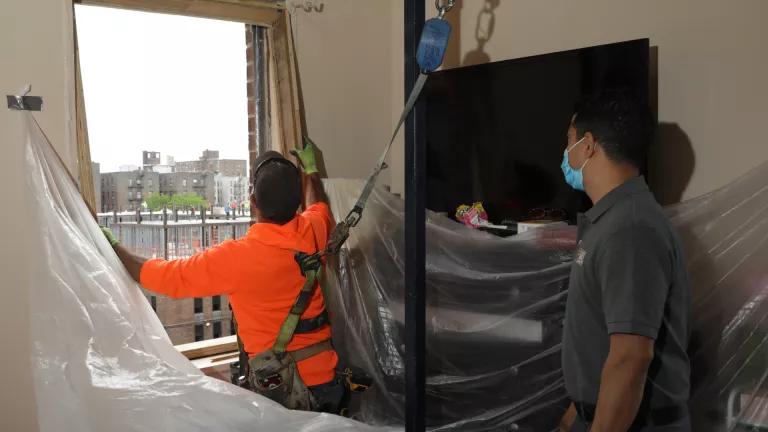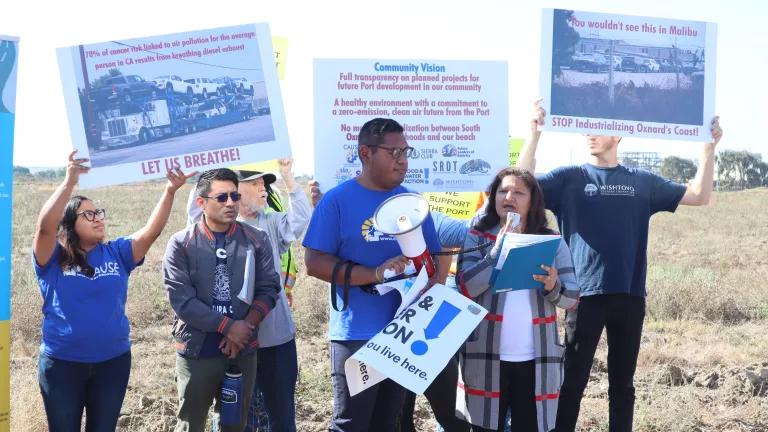
Francis Rodriguez, Director of weatherization at the nonprofit Association for Energy Affordability (AEA), assists an AEA worker installing a new energy efficient window at an apartment in the South Bronx, New York City.
Natalie Keyssar for NRDC
As California continues to ramp up its efforts to support building retrofits targeting energy efficiency, decarbonization, and electrification, other housing issues regarding health and safety have also become more apparent. Low-income residents and communities of color disproportionately experience housing quality issues that impact their health, such as lead paint and poor ventilation. While existing and emerging energy retrofit programs present an opportunity to examine health needs alongside energy needs, they vary in how effectively they identify and support the health and safety upgrades that are needed to improve housing quality, resident health, and comfort. To help address this gap, NRDC partnered with the Association for Energy Affordability (AEA) to better understand the outstanding health and safety needs for affordable housing buildings already being served under ongoing energy efficiency and electrification programs in California, such as the Low Income Weatherization Program (LIWP), the Multifamily Affordable Housing Electrification Program (MAHEP), and LADWP’s Comprehensive Affordable Multifamily Retrofits Program (CAMR).
As a technical assistance provider for LIWP, MAHEP, and CAMR, AEA Technical Analysts regularly conduct on-site energy efficiency and electrification assessments of multifamily properties. Given this, AEA was well positioned to pilot the integration of health and safety (H&S) criteria in their assessments, collecting field data based on this criteria, with the goal of guiding future assessments targeting energy and health together. H&S criteria was compiled based on six categories: air quality, behavioral health, electrical, hazardous materials (“hazmat”), building safety, and water (See Figure 1). After compiling criteria, AEA developed a Health and Safety Assessment template to capture information while evaluating H&S needs and opportunities in multifamily buildings. Prior to the development of the template, identified building and tenant concerns had not been analyzed and/or documented holistically in this manner. In total, six affordable housing multifamily buildings in California were evaluated using the pilot Health and Safety Assessment template.

Figure 1: Concerns evaluated in Health and Safety Assessments
The Association for Energy Affordability
Though focused on a small number of buildings, the information gathered from this project provided an initial look at common health and safety needs in multifamily affordable housing. The most notable trend was that all six properties evaluated had an identifiable need related to air quality, referencing issues with bathroom ventilation, windows, and/or stove ventilation - all of which can significantly negatively impact indoor environmental quality.
Inadequate ventilation, identified as a concern in five out of six properties, can have several detrimental health impacts. Take, for example, a building with infiltration-only ventilation: exhaust fans and windows are major drivers of air exchange between indoors and outdoors, in particular allowing humid, moist air from bathrooms to be vented outside. If bathrooms do not have functioning exhaust fans or windows, the repeated indoor accumulation of damp and humid air from bathing can cause negative health consequences for residents, such as raising asthma risks and promoting mold growth. Similarly, if kitchens do not have functioning, externally vented hoods or windows, pollutants related to gas stoves and cooking can accumulate to high levels indoors, raising risks of asthma and other diseases. Adequate ventilation is one of the foundational elements of healthy buildings, yet these types of repairs are generally not assessed, prioritized by existing programs or building owners, or adequately funded.
Window issues were also specifically called out as an air quality concern at five out of six properties. Window upgrades and proper sealing can improve energy efficiency for heating and cooling (therefore enabling greater thermal comfort), reduce noise pollution, limit indoor exposure to poor outdoor air quality, and improve indoor environmental quality by preventing outside pollutants and moisture from entering the living space.
Overall, this pilot found that including H&S concerns in traditional building energy assessments added minimal additional training or assessment time for Technical Analysts. By standardizing collection of H&S data, we were able to identify consistent indoor air quality concerns across the pilot properties evaluated, and the need for programs to address ventilation and window upgrades and repairs to support resident health along with building energy efficiency.
We recommend that H&S criteria be integrated into building assessments as standard best practice, and that state and local agencies should direct additional funding to existing programs to address common identified ventilation and window problems. There is precedent for California public entities providing funding for window upgrades in communities impacted by a specific commercial source of noise: Los Angeles International Airport (LAX) hosts the Residential Sound Insulation Program (RSI program), providing services ranging from retrofitting exterior doors and windows to installing ventilation systems for buildings within the noise contours around LAX in order to reduce noise pollution. Another option would be to leverage health department resources to supplement building upgrade program funding to cover ventilation and window upgrades for affordable housing.
We have a significant opportunity to increase the beneficial impacts of our building programs by making some small, simple changes. The return on these investments - better indoor quality and decreased health risks for affordable housing residents - are well worth it.
The Association for Energy Affordability (AEA) is dedicated to achieving energy efficiency in new and existing buildings in order to foster and maintain affordable and healthy housing and communities, especially those of low-income. AEA representatives engage in a broad range of educational, technical and construction management activities and services to promote this mission and develop the industry that advances and sustains it. AEA supports multifamily buildings in the States of New York and California.




